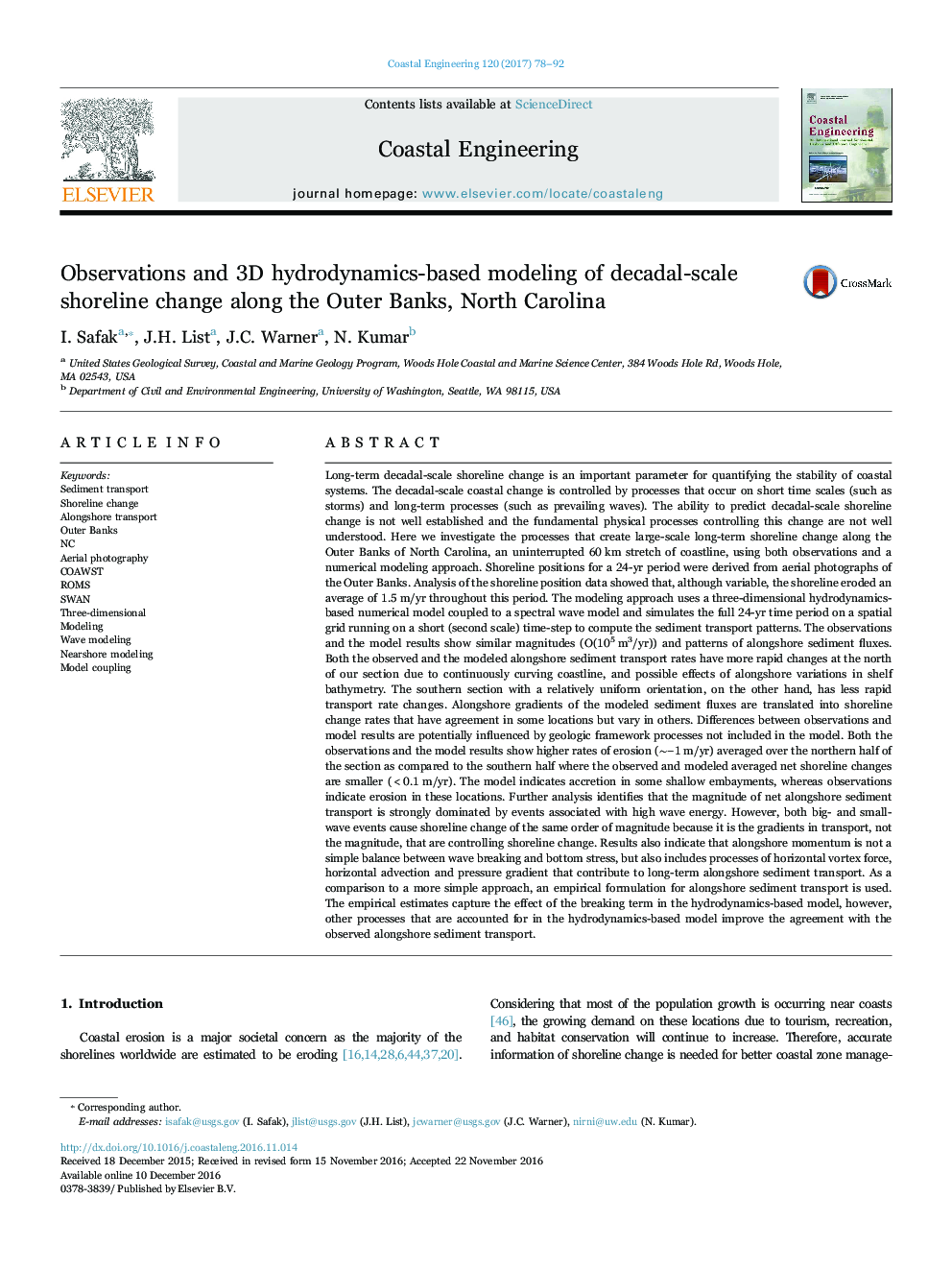| کد مقاله | کد نشریه | سال انتشار | مقاله انگلیسی | نسخه تمام متن |
|---|---|---|---|---|
| 5473491 | 1520334 | 2017 | 15 صفحه PDF | دانلود رایگان |
عنوان انگلیسی مقاله ISI
Observations and 3D hydrodynamics-based modeling of decadal-scale shoreline change along the Outer Banks, North Carolina
دانلود مقاله + سفارش ترجمه
دانلود مقاله ISI انگلیسی
رایگان برای ایرانیان
کلمات کلیدی
موضوعات مرتبط
مهندسی و علوم پایه
سایر رشته های مهندسی
مهندسی دریا (اقیانوس)
پیش نمایش صفحه اول مقاله

چکیده انگلیسی
Long-term decadal-scale shoreline change is an important parameter for quantifying the stability of coastal systems. The decadal-scale coastal change is controlled by processes that occur on short time scales (such as storms) and long-term processes (such as prevailing waves). The ability to predict decadal-scale shoreline change is not well established and the fundamental physical processes controlling this change are not well understood. Here we investigate the processes that create large-scale long-term shoreline change along the Outer Banks of North Carolina, an uninterrupted 60 km stretch of coastline, using both observations and a numerical modeling approach. Shoreline positions for a 24-yr period were derived from aerial photographs of the Outer Banks. Analysis of the shoreline position data showed that, although variable, the shoreline eroded an average of 1.5 m/yr throughout this period. The modeling approach uses a three-dimensional hydrodynamics-based numerical model coupled to a spectral wave model and simulates the full 24-yr time period on a spatial grid running on a short (second scale) time-step to compute the sediment transport patterns. The observations and the model results show similar magnitudes (O(105 m3/yr)) and patterns of alongshore sediment fluxes. Both the observed and the modeled alongshore sediment transport rates have more rapid changes at the north of our section due to continuously curving coastline, and possible effects of alongshore variations in shelf bathymetry. The southern section with a relatively uniform orientation, on the other hand, has less rapid transport rate changes. Alongshore gradients of the modeled sediment fluxes are translated into shoreline change rates that have agreement in some locations but vary in others. Differences between observations and model results are potentially influenced by geologic framework processes not included in the model. Both the observations and the model results show higher rates of erosion (â¼â1 m/yr) averaged over the northern half of the section as compared to the southern half where the observed and modeled averaged net shoreline changes are smaller (<0.1 m/yr). The model indicates accretion in some shallow embayments, whereas observations indicate erosion in these locations. Further analysis identifies that the magnitude of net alongshore sediment transport is strongly dominated by events associated with high wave energy. However, both big- and small- wave events cause shoreline change of the same order of magnitude because it is the gradients in transport, not the magnitude, that are controlling shoreline change. Results also indicate that alongshore momentum is not a simple balance between wave breaking and bottom stress, but also includes processes of horizontal vortex force, horizontal advection and pressure gradient that contribute to long-term alongshore sediment transport. As a comparison to a more simple approach, an empirical formulation for alongshore sediment transport is used. The empirical estimates capture the effect of the breaking term in the hydrodynamics-based model, however, other processes that are accounted for in the hydrodynamics-based model improve the agreement with the observed alongshore sediment transport.
ناشر
Database: Elsevier - ScienceDirect (ساینس دایرکت)
Journal: Coastal Engineering - Volume 120, February 2017, Pages 78-92
Journal: Coastal Engineering - Volume 120, February 2017, Pages 78-92
نویسندگان
I. Safak, J.H. List, J.C. Warner, N. Kumar,